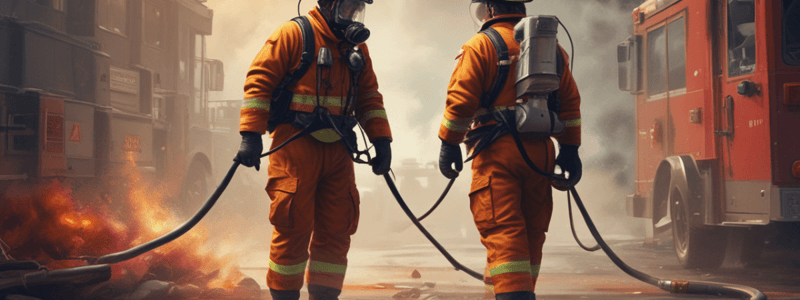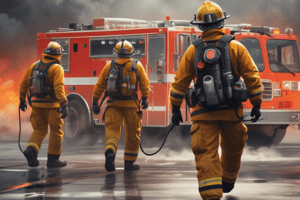Podcast
Questions and Answers
What is the primary purpose of Gross Decontamination for Fire Rescue personnel?
What is the primary purpose of Gross Decontamination for Fire Rescue personnel?
- To improve physical fitness after a fire incident
- To prepare equipment for the next operation
- To provide psychological support to the team
- To remove products of combustion and reduce toxin exposure (correct)
Who is responsible for establishing and overseeing the Gross Decon area?
Who is responsible for establishing and overseeing the Gross Decon area?
- The Driver Operator (correct)
- The first arriving firefighter
- The incident commander
- The safety officer
What should be used for the water source in the Gross Decon process?
What should be used for the water source in the Gross Decon process?
- Clean municipal water from a hydrant (correct)
- Rainwater collected from the scene
- Stagnant water from a nearby pond
- Contaminated water collected from the site
What is an essential item recommended for a personal 'Go-Bag'?
What is an essential item recommended for a personal 'Go-Bag'?
What configuration is preferred for the Decon Hose Line used during Gross Decon?
What configuration is preferred for the Decon Hose Line used during Gross Decon?
What marking is used to designate the nozzle location at the Gross Decon area?
What marking is used to designate the nozzle location at the Gross Decon area?
In which zone should Gross Decon be located?
In which zone should Gross Decon be located?
What is advised prior to entering Rehabilitation after exposure to toxins?
What is advised prior to entering Rehabilitation after exposure to toxins?
What is the primary goal during the gross decontamination process for Bunker gear?
What is the primary goal during the gross decontamination process for Bunker gear?
Which areas should personnel pay special attention to during rinsing to prevent accumulation?
Which areas should personnel pay special attention to during rinsing to prevent accumulation?
Where should all PPE be left after decontamination, except for Bunker pants and structural boots?
Where should all PPE be left after decontamination, except for Bunker pants and structural boots?
Which method is recommended for cleaning PPE during the gross decontamination process?
Which method is recommended for cleaning PPE during the gross decontamination process?
What should personnel use after doffing their PPE in the Drop Zone for cleaning exposed areas?
What should personnel use after doffing their PPE in the Drop Zone for cleaning exposed areas?
What is the recommended action for personnel after exiting the Hot zone?
What is the recommended action for personnel after exiting the Hot zone?
Which NFPA guideline should be followed when cleaning PPE?
Which NFPA guideline should be followed when cleaning PPE?
Which is the correct sequence for personnel reporting to Rehabilitation after decontamination?
Which is the correct sequence for personnel reporting to Rehabilitation after decontamination?
What is the primary purpose of performing Gross Decon processes before leaving the incident scene?
What is the primary purpose of performing Gross Decon processes before leaving the incident scene?
Which step must be taken with contaminated Bunker gear before leaving the scene?
Which step must be taken with contaminated Bunker gear before leaving the scene?
How should the Decon Bag be sealed after placing contaminated gear inside?
How should the Decon Bag be sealed after placing contaminated gear inside?
What specific type of cleaning product should be used for cleaning equipment at the scene?
What specific type of cleaning product should be used for cleaning equipment at the scene?
Which of the following actions is NOT appropriate for contaminated PPE?
Which of the following actions is NOT appropriate for contaminated PPE?
What type of brush is recommended for cleaning equipment during the Gross Decon process?
What type of brush is recommended for cleaning equipment during the Gross Decon process?
What should be cleaned using Fire Rescue approved wipes?
What should be cleaned using Fire Rescue approved wipes?
In the context of crew assignments, when should a crew go through the Gross Decon process?
In the context of crew assignments, when should a crew go through the Gross Decon process?
What is the primary objective of the Post Fire Gross Decontamination procedure?
What is the primary objective of the Post Fire Gross Decontamination procedure?
Which of the following incidents does the Gross Decontamination procedure apply to?
Which of the following incidents does the Gross Decontamination procedure apply to?
What is the significance of following NFPA and OSHA regulations in the Gross Decontamination process?
What is the significance of following NFPA and OSHA regulations in the Gross Decontamination process?
How should the Gross Decontamination process be conducted according to the standard operating guideline?
How should the Gross Decontamination process be conducted according to the standard operating guideline?
Who holds the authority to enforce the Post Fire Gross Decontamination procedures?
Who holds the authority to enforce the Post Fire Gross Decontamination procedures?
What does SOG 700-01 specifically refer to in relation to the Gross Decontamination process?
What does SOG 700-01 specifically refer to in relation to the Gross Decontamination process?
Which part of the Gross Decontamination process is deemed unnecessary by this guideline?
Which part of the Gross Decontamination process is deemed unnecessary by this guideline?
Why is it essential for all members of Fire Rescue to adhere to the Gross Decontamination protocols?
Why is it essential for all members of Fire Rescue to adhere to the Gross Decontamination protocols?
What is the recommended action for maintaining readiness after decontamination of PPE?
What is the recommended action for maintaining readiness after decontamination of PPE?
Which of the following is NOT part of the post-fire decontamination process?
Which of the following is NOT part of the post-fire decontamination process?
How often should vehicle cabs be cleaned and decontaminated to limit secondary exposures?
How often should vehicle cabs be cleaned and decontaminated to limit secondary exposures?
What is the purpose of using fans when drying cleaned PPE?
What is the purpose of using fans when drying cleaned PPE?
What is the maximum time frame for units to report back available to the Communication Center after being out-of-service?
What is the maximum time frame for units to report back available to the Communication Center after being out-of-service?
What should be minimized to reduce the potential for secondary exposures during routine vehicle use?
What should be minimized to reduce the potential for secondary exposures during routine vehicle use?
What should be done one hour after a fire response to maintain readiness?
What should be done one hour after a fire response to maintain readiness?
Which of the following actions does NOT help with the off-gassing of PPE components?
Which of the following actions does NOT help with the off-gassing of PPE components?
Flashcards
Gross Decon
Gross Decon
A process used to remove harmful particles from firefighters' equipment and clothing after exposure to fire.
Decontamination Zone
Decontamination Zone
Area within the incident scene where firefighters systematically wash off dangerous substances after fire exposure.
Decon Process
Decon Process
Firefighters must clean off debris systematically, starting from the top and working their way down.
Drop Zone
Drop Zone
Signup and view all the flashcards
Rehabilitation Zone
Rehabilitation Zone
Signup and view all the flashcards
Leaving the Scene Decon
Leaving the Scene Decon
Signup and view all the flashcards
Decon Bag
Decon Bag
Signup and view all the flashcards
Reporting for Re-Assignment
Reporting for Re-Assignment
Signup and view all the flashcards
PPE Exchange
PPE Exchange
Signup and view all the flashcards
Clean Bunker Gear Storage
Clean Bunker Gear Storage
Signup and view all the flashcards
Off-gassing Gear with Fans
Off-gassing Gear with Fans
Signup and view all the flashcards
Vehicle Cab Decontamination
Vehicle Cab Decontamination
Signup and view all the flashcards
Regular Cab Cleaning
Regular Cab Cleaning
Signup and view all the flashcards
NFPA 1851 and 1971-1974
NFPA 1851 and 1971-1974
Signup and view all the flashcards
OSHA Regulations (29 CFR 1910.156(e)(3)(ii))
OSHA Regulations (29 CFR 1910.156(e)(3)(ii))
Signup and view all the flashcards
Go-Bag
Go-Bag
Signup and view all the flashcards
Driver Operator Role
Driver Operator Role
Signup and view all the flashcards
Clean Water Source
Clean Water Source
Signup and view all the flashcards
Green Traffic Cone
Green Traffic Cone
Signup and view all the flashcards
Contaminated Gear Bagging
Contaminated Gear Bagging
Signup and view all the flashcards
The Gross Decon process shall be utilized on all fires where PPE is worn and exposed to products of combustion. This shall include, but not be limited to:
The Gross Decon process shall be utilized on all fires where PPE is worn and exposed to products of combustion. This shall include, but not be limited to:
Signup and view all the flashcards
All Fire Rescue personnel that were exposed to ______ shall
perform Gross Decon prior to entering Rehabilitation (Rehab), leaving the incident, or training activity.
All Fire Rescue personnel that were exposed to ______ shall perform Gross Decon prior to entering Rehabilitation (Rehab), leaving the incident, or training activity.
Signup and view all the flashcards
Gross Decon shall be located in
Gross Decon shall be located in
Signup and view all the flashcards
Gross Decon should be set up by the ______ closest to the products of combustion.
Gross Decon should be set up by the ______ closest to the products of combustion.
Signup and view all the flashcards
It shall be the ______ responsibility to establish and oversee the
Gross Decon area and process.
It shall be the ______ responsibility to establish and oversee the Gross Decon area and process.
Signup and view all the flashcards
The Driver Operator shall ensure that the apparatus tank water or any water used in the Gross Decon process is from a ____ and is not stagnant or contaminated water.
The Driver Operator shall ensure that the apparatus tank water or any water used in the Gross Decon process is from a ____ and is not stagnant or contaminated water.
Signup and view all the flashcards
The Gross Decon area shall be designated by ____ and marking the nozzle location with a GREEN traffic cone.
The Gross Decon area shall be designated by ____ and marking the nozzle location with a GREEN traffic cone.
Signup and view all the flashcards
The Decon Hose Line is a brush-fire flat hose equipped with a garden style nozzle and a
The Decon Hose Line is a brush-fire flat hose equipped with a garden style nozzle and a
Signup and view all the flashcards
This setup is preferred as it provides flushing with high flow but
This setup is preferred as it provides flushing with high flow but
Signup and view all the flashcards
Personnel shall rinse off debris and products of combustion in a systematic and thorough manner from the
Personnel shall rinse off debris and products of combustion in a systematic and thorough manner from the
Signup and view all the flashcards
being mindful of higher potential collection points, such as
being mindful of higher potential collection points, such as
Signup and view all the flashcards
Soft bristle scrub brushes and a Fire Rescue approved ____ may be
used to facilitate the PPE cleaning process.
Soft bristle scrub brushes and a Fire Rescue approved ____ may be used to facilitate the PPE cleaning process.
Signup and view all the flashcards
NFPA 1851
NFPA 1851
Signup and view all the flashcards
The Drop Zone shall be located:
The Drop Zone shall be located:
Signup and view all the flashcards
After doffing PPE in the Drop Zone, personnel shall use Fire Rescue approved wipes for a gross cleaning of their
After doffing PPE in the Drop Zone, personnel shall use Fire Rescue approved wipes for a gross cleaning of their
Signup and view all the flashcards
Once released by the Incident Commander and prior to leaving the scene contaminated ___ shall be bagged using the Fire Rescue approved Decon Bags.
Once released by the Incident Commander and prior to leaving the scene contaminated ___ shall be bagged using the Fire Rescue approved Decon Bags.
Signup and view all the flashcards
The Decon Bag opening shall be twisted and taped closed, then “goose-necked” (folded over on itself, and twisted and
The Decon Bag opening shall be twisted and taped closed, then “goose-necked” (folded over on itself, and twisted and
Signup and view all the flashcards
All other equipment (i.e., helmet exteriors, SCBA packs and cylinders, tools, radio straps, etc...) shall be thoroughly cleaned and scrubbed on scene using
All other equipment (i.e., helmet exteriors, SCBA packs and cylinders, tools, radio straps, etc...) shall be thoroughly cleaned and scrubbed on scene using
Signup and view all the flashcards
Radios shall be cleaned with
Radios shall be cleaned with
Signup and view all the flashcards
Personnel determined by the _____ to have been exposed shall have their hood exchanged prior to leaving the scene
Personnel determined by the _____ to have been exposed shall have their hood exchanged prior to leaving the scene
Signup and view all the flashcards
The potential for secondary exposures during
The potential for secondary exposures during
Signup and view all the flashcards
To aid in reducing secondary exposures, vehicle cabs shall be ____ on a regular basis.
To aid in reducing secondary exposures, vehicle cabs shall be ____ on a regular basis.
Signup and view all the flashcards
Study Notes
Purpose and Authority
- Establishes a safe method for removing toxic particles from equipment and PPE after fire exposure.
- Aims to reduce firefighter exposure and improve long-term health outcomes.
- Governed by Fire Rescue Administrator, NFPA standards (1851, 1971-1974), and OSHA regulations (29 CFR 1910.156(e)(3)(ii)).
Scope
- Applicable to all personnel involved in Emergency Operations.
On Scene Post Fire Gross Decontamination
- Focuses on systematic decontamination after exposure to combustion products.
- Required after all fire incidents where PPE is worn (structure, wildland, vehicle, training, other emergencies).
Preparation
- Recommended to create a personal "Go-Bag" for quick access to a clean uniform post-exposure.
- Suggested items include Class D uniform, clean socks and footwear, hat, towel, and sun protection.
Gross Decon Setup
- Gross Decon should be located in the warm zone, close to the products of combustion.
- The Driver Operator establishes and oversees the decontamination area.
- Must use clean municipal water source to avoid contamination.
- Designate the decon area with a green traffic cone and deploy a Decon Hose Line.
Gross Decon Process
- Personnel should rinse off debris systematically, starting from the collar-line down.
- Avoid saturating the inner lining of the Bunker gear to maintain operational readiness.
- Soft bristle scrub brushes and Fire Rescue approved soaps may be utilized.
- Follow NFPA 1851 and manufacturer guidelines for PPE cleaning.
Drop Zone
- Separate area for leaving contaminated PPE, excluding of Bunker pants and structural boots.
- Drop Zone should be remote and downwind of Rehabilitation to manage off-gassing.
Rehabilitation
- Gross decontamination is mandatory before entering Rehabilitation.
Reporting for Re-Assignment
- Crews returning to operations must report ready for assignment and re-do Gross Decon if further exposure to combustion products is expected.
Release from the Scene
- Thoroughly perform Gross Decon before leaving the incident to prevent corruption of vehicle interiors.
- Contaminated PPE must be bagged in approved Decon Bags, sealed and secured to minimize off-gassing.
- All equipment must be cleaned on site with approved products.
Personal Protective Equipment Exchange
- Complete thorough decontamination of PPE and vehicle cabs after exposure.
- Return the vehicle to a ready state and ensure all gear is clean.
Ability to Respond
- Clean Bunker gear should be stored appropriately to facilitate drying and off-gassing.
- Use fans to enhance the off-gassing process, ensuring readiness without hindering response times.
Maintaining Readiness
- Ensure vehicle cabs are clean to minimize secondary exposure risks.
- Regular cleaning and decontamination of cabs are necessary for operational safety.
Studying That Suits You
Use AI to generate personalized quizzes and flashcards to suit your learning preferences.



